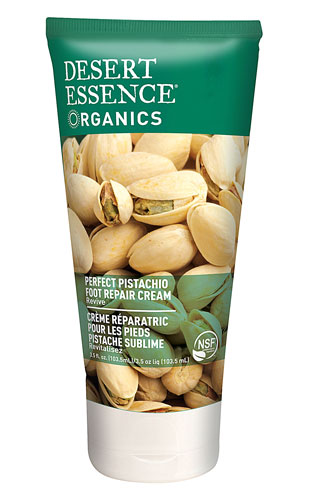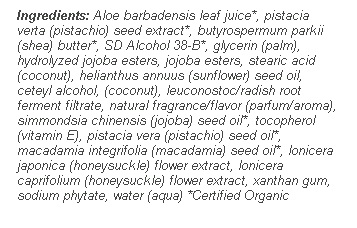Ingredients
- Click on any Ingredient below to learn more about it at NutraWiki
| Aloe barbadensis leaf juice | Aloe Barbadensis leaf juice, or Aloe Vera as it is more commonly known, is extracted from the leaves of the plant Aloe. |
|---|---|
| Pistacia vera | This ingredient is currently being researched thoroughly by our team. A NutraWiki page summarizing our findings will be available soon. |
| Butyrospermum parkii | Shea butter has many uses and may or may not be refined. In the West it is mostly used for cosmetics as emollient. Throughout Africa it is used extensively for food, is a major source of dietary fat, and for medicinal purposes. |
| SD Alcohol 38-B | This ingredient is currently being researched thoroughly by our team. A NutraWiki page summarizing our findings will be available soon. |
| Glycerin | Emollient (Moisturizer) |
| Hydrolyzed jojoba esters | There is an interest in using jojoba for balding because some people think that unclogged hair follicles are more likely to produce new hair. |
| Jojoba esters | There is an interest in using jojoba for balding because some people think that unclogged hair follicles are more likely to produce new hair. |
| Stearic acid | Stearic acid is one of many fatty acids that occur naturally in various plants and animal derivatives. It’s found in such products as animal tallow, cocoa butter and vegetable fats. When it’s used in cosmetic products, stearic acid primarily fulfills the role of a thickener or hardener. Stearic acid is the substance that helps your bar of soap retain its shape — just as it does in products such as candles, oil pastels and hard candies. |
| Helianthus annuus | The seeds have diuretic and expectorant properties and have been employed with success in the treatment of bronchial, laryngeal and pulmonary affections, coughs and colds, also in whooping cough. |
| Cetyl alcohol | Cetyl alcohol is used in the cosmetic industry as an opacifier in shampoos, or as an emollient, emulsifier or thickening agent in the manufacture of skin creams and lotions. It is also employed as a lubricant for nuts and bolts, and is the active ingredient in some “liquid pool covers” (forming a surface layer to reduce evaporation and retain heat). |
| Leuconostoc/radish root ferment filtrate | Derived from radishes fermented with Leuconostoc kimchii, a lactic acid bacteria that has traditionally been used to make kimchi, this product consists of an isolated peptide that is secreted from the bacteria during the fermentation process that has been shown to have antimicrobial benefits. |
| Natural fragrance/flavor | This ingredient is currently being researched thoroughly by our team. A NutraWiki page summarizing our findings will be available soon. |
| Simmondsia chinensis | In manufacturing, jojoba is used as an ingredient in shampoo; lipstick; makeup; cleansing products; and in face, hand, and body lotions. |
| Tocopherol | Antoxidants - Anti-Aging Agent |
| Pistacia vera | This ingredient is currently being researched thoroughly by our team. A NutraWiki page summarizing our findings will be available soon. |
| Macadamia integrifolia | Although the presence of a large amount of oil puts many people off, much of the oil in macadamia nuts is actually healthy. It consists of mono-saturated fat. This is the kind of fat that is good for the body when eaten in proper amounts. However, it is suggested that daily fat intake should be no more than 35 percent of the day’s total calorie consumption. |
| Lonicera japonica | Maintain Blood Sugar Level |
| Lonicera caprifolium | Swelling (inflammation) of small air passages in the lung (bronchiolitis) |
| Xanthan gum | Xanthan gum is a sugar-like compound made by mixing aged (fermented) sugars with a certain kind of bacteria. |
| Sodium phytate | Phytase is an enzyme that has the ability to liberate the phosphate and mineral residues from phytic acid (phytate), a compound formed during the maturation process of plant seeds and grains that is commonly found in plant-based foods. |




Reviews
There are no reviews yet.